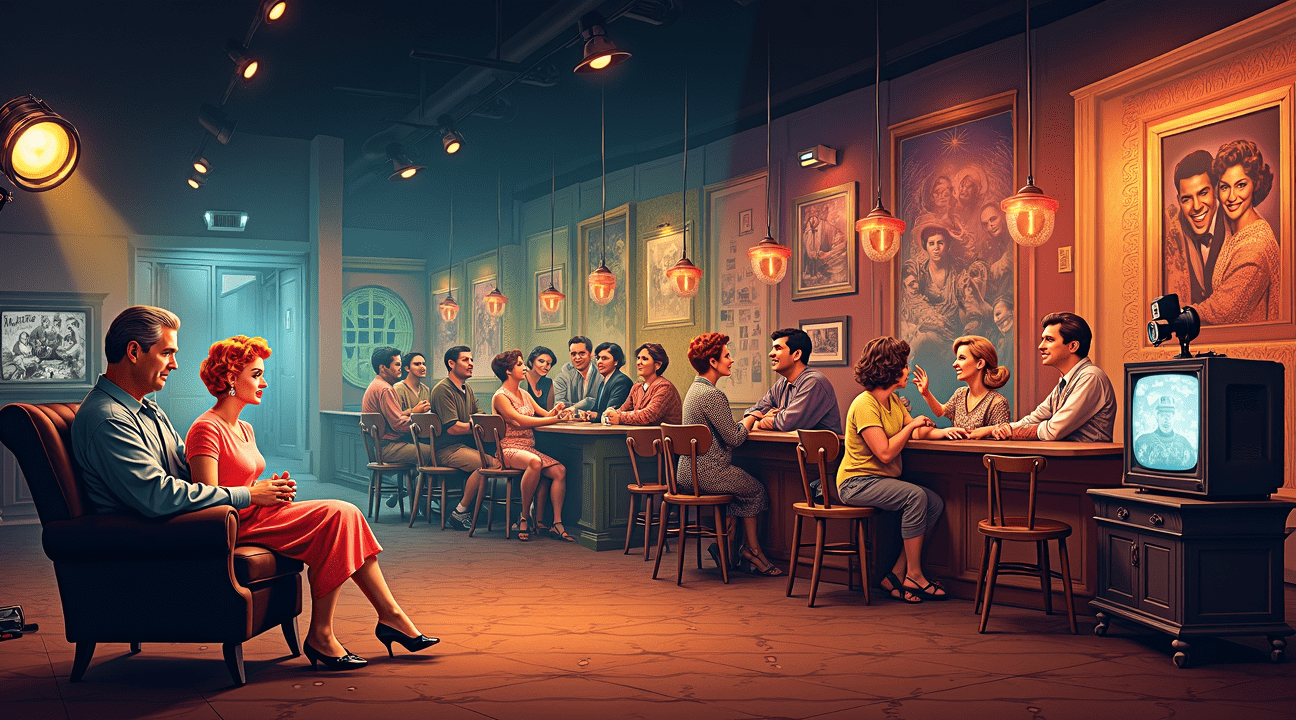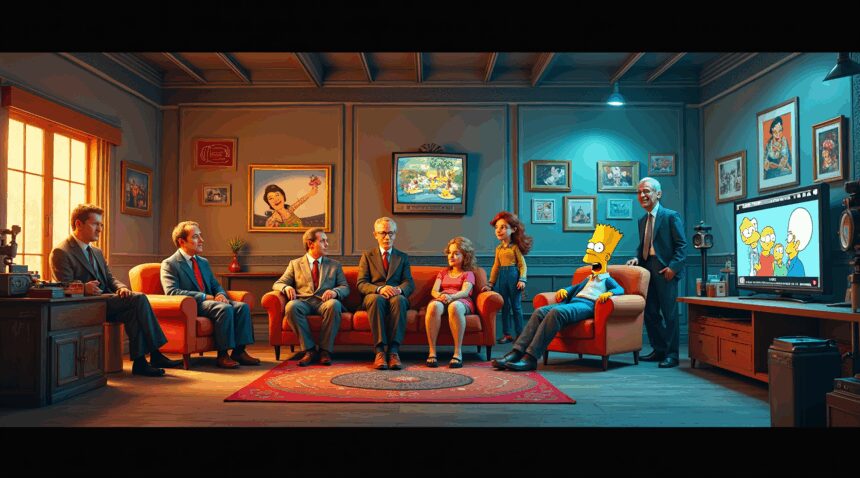The sitcom genre has experienced remarkable transformation from its humble radio origins in the 1920s with Sam ‘n’ Henry to today’s streaming-dominated landscape, where platforms like Netflix and Hulu shape how audiences consume comedy television.
This evolution spans nearly a century of technological innovation, cultural shifts, and creative breakthroughs that have redefined what situational comedy can accomplish. From The Simpsons‘ groundbreaking 750+ episode run to modern dramedies like The Bear that blur traditional genre boundaries, sitcoms have continuously reinvented themselves to resonate with evolving audiences.
Key Takeaways
- Radio to streaming revolution: Sitcoms evolved from 1920s radio shows like Sam ‘n’ Henry to modern streaming-first productions, adapting to new technologies while maintaining their core appeal of character-driven humor.
- Production format transformation: The shift from multi-camera setups with laugh tracks to single-camera mockumentary styles, exemplified by The Office, fundamentally changed how audiences experience television comedy.
- Social commentary integration: Norman Lear’s groundbreaking shows like All in the Family proved sitcoms could tackle serious social issues while still entertaining, establishing comedy as a vehicle for meaningful cultural discourse.
- Global format exchange: British comedies provided blueprints for American classics like The Office and All in the Family, creating an international sitcom ecosystem where successful formats adapt across cultures worldwide.
- Animation’s mainstream acceptance: The Simpsons’ 35-year run, alongside successes like South Park and Family Guy, established animated sitcoms as legitimate formats capable of sophisticated storytelling and adult themes.
To explore more about how platforms like Netflix and Hulu influence modern sitcom trends, you can visit their official websites and browse through their comedy selections.
How The Simpsons Changed Everything: From Radio’s Sam ‘n’ Henry to Today’s Streaming Giants
The sitcom didn’t start with a laugh track or even a television screen. I trace its origins back to radio shows of the 1920s, when broadcasters first discovered the power of situational comedy to captivate audiences week after week. Sam ‘n’ Henry premiered in 1926, establishing the foundation for what would become one of entertainment’s most enduring formats. By 1928, the show evolved into Amos ‘n’ Andy, cementing the concept of character-driven comedy that relied on familiar situations and recurring themes.
Television Takes Center Stage
Television brought sitcoms into American living rooms with Mary Kay and Johnny in 1947, marking the first American television sitcom. Meanwhile, the United Kingdom had already broken ground with Pinwright’s Progress in 1946, claiming the distinction of being the world’s first television sitcom. These early shows established the visual language and storytelling techniques that would define comedy television for decades.
The medium found its rhythm through shows that understood the intimate nature of television viewing. Unlike radio, which relied entirely on dialogue and sound effects, television sitcoms could use physical comedy, facial expressions, and visual gags to enhance their storytelling. This shift opened new creative possibilities and allowed for more sophisticated character development.
The Simpsons Revolution and Beyond
Everything changed when The Simpsons launched in 1989. I consider this animated series a watershed moment that redefined what sitcoms could accomplish. With over 750 episodes as of 2024, it stands as the longest-running U.S. sitcom, proving that animated comedy could sustain audience interest across multiple generations. The show’s success demonstrated that sitcoms could tackle serious social issues while maintaining their comedic core, paving the way for more ambitious storytelling approaches.
Modern sitcoms have embraced this expanded definition of comedy. Shows like The Bear exemplify this evolution by winning comedic awards despite their dramedy nature, blending humor with genuine emotional depth and dramatic tension. This shift reflects audiences’ growing appetite for complex narratives that don’t fit neatly into traditional genre categories.
The streaming revolution has fundamentally altered how sitcoms reach audiences and tell their stories. Netflix, Hulu, and Peacock now dominate production, with new releases scheduled well into 2025. These platforms offer creators unprecedented freedom to experiment with format, episode length, and narrative structure. Unlike traditional network television, streaming services don’t need to accommodate commercial breaks or fit rigid time slots, allowing for more organic storytelling rhythms.
Streaming giants have also revived interest in classic sitcoms while simultaneously pushing creative boundaries with original content. The success of shows like How I Met Your Mother on streaming platforms demonstrates how digital distribution can extend a show’s cultural impact far beyond its original broadcast run. Similarly, beloved series continue finding new audiences through these platforms.
The industry continues evolving with announcements like The Office reboot rumors and fresh Big Bang Theory installments. These developments show how streaming services leverage nostalgia while creating space for innovation. Shows like The Big Bang Theory and Community have found second lives on streaming platforms, often gaining larger audiences than during their original television runs.
Today’s sitcom landscape reflects nearly a century of evolution, from Sam ‘n’ Henry’s radio beginnings to today’s streaming-first productions. The format has proven remarkably adaptable, incorporating new technologies, storytelling techniques, and cultural perspectives while maintaining its core appeal: making people laugh while exploring the human condition. This flexibility ensures that sitcoms will continue evolving, finding new ways to connect with audiences regardless of how entertainment consumption patterns change.
I Love Lucy’s Revolutionary Impact and the Rise of Social Commentary
Technical Innovation That Changed Everything
I Love Lucy transformed television production when it debuted in 1951, pioneering the multiple-camera setup that became the industry standard. This groundbreaking approach allowed Lucille Ball and Desi Arnaz to capture performances from multiple angles simultaneously, creating a more dynamic viewing experience. The show’s 181 episodes across six seasons consistently dominated ratings, making it the most-watched show for several seasons during its original run from 1951 to 1957.
The technical excellence established by I Love Lucy influenced countless productions that followed. The Honeymooners, which ran from 1955 to 1956, built upon this foundation with its 39-episode run that fans now call the “Classic 39.” Jackie Gleason’s portrayal of Ralph Kramden and the show’s working-class perspective created a template that would resonate through decades of television comedy.
The Shift from Pure Entertainment to Social Awareness
Television comedy experienced a dramatic transformation during the 1960s and 1970s as producers began addressing real social issues rather than simply providing escapist entertainment. Norman Lear spearheaded this evolution with groundbreaking shows that tackled controversial topics head-on. All in the Family challenged audiences with discussions about racism, politics, and generational conflicts through the character of Archie Bunker. The Jeffersons continued this tradition by exploring interracial relationships and class mobility, while One Day at a Time addressed single parenthood and women’s liberation.
Lear’s work demonstrated that sitcoms could entertain while simultaneously educating viewers about social issues and reflecting the changing American family structure. This period established comedy as a powerful vehicle for social commentary, influencing how future shows would approach sensitive topics.
Several other influential series emerged during this transformative era, each contributing unique elements to the genre’s development:
- The Beverly Hillbillies brought rural comedy to urban audiences, highlighting cultural differences across America
- Bewitched combined domestic situations with supernatural elements, subtly addressing women’s roles in society
- The Dick Van Dyke Show offered sophisticated writing and explored the entertainment industry itself
- The Mary Tyler Moore Show featured an independent working woman, breaking new ground for female representation
- Cheers later perfected the ensemble cast format in a workplace setting
These shows established many conventions that modern sitcoms still follow today. How I Met Your Mother and other contemporary series owe much to the character development techniques pioneered during this era. Similarly, workplace comedies like The Office trace their DNA back to shows like The Mary Tyler Moore Show.
The impact of this evolutionary period can’t be overstated. Classic sitcoms from the 1950s through 1970s created the framework for everything that followed, establishing both technical standards and thematic approaches that continue influencing production today. The Big Bang Theory and other modern hits still rely on the multi-camera setup that I Love Lucy introduced over 70 years ago.
This era proved that television comedy could be both commercially successful and culturally significant. Shows like Community continue pushing boundaries in ways that Norman Lear and his contemporaries would recognize and appreciate. The foundation they built during these crucial decades enabled sitcoms to evolve into sophisticated vehicles for both entertainment and meaningful social discourse.

Cable TV’s Game-Changing Role in Sitcom Diversity and Animation’s Mainstream Breakthrough
The 1980s marked a pivotal shift in sitcom programming as cable television emerged as a powerful force in entertainment distribution. I’ve observed how this technological advancement fundamentally altered what kinds of shows could reach audiences, creating opportunities for more specialized content that broadcast networks wouldn’t risk producing.
Cable’s expansion by the mid-1980s enabled targeted programming strategies that transformed sitcom development. Networks could now focus on specific demographics rather than appealing to the broadest possible audience. This shift proved particularly beneficial for shows aimed at younger viewers, with series like Saved by the Bell and Clarissa Explains It All finding success through niche programming approaches that traditional broadcasters had previously avoided.
The period also witnessed experimentation with dramedy formats, blending comedic elements with more serious dramatic storylines. Shows like United States and The Days and Nights of Molly Dodd pushed creative boundaries, though these hybrid formats struggled to achieve commercial success. Their limited appeal demonstrated that audiences weren’t quite ready for such genre-blending approaches during this transitional period.
Animation’s Renaissance and Sitcom Icons
The late 1980s and 1990s brought about a remarkable renaissance in animated sitcoms.
- South Park
- Futurama
- Family Guy
- King of the Hill
Each carved out distinct comedic territories, proving that animation could successfully tackle adult themes while maintaining broad appeal. This era established animation as a legitimate sitcom format capable of sophisticated storytelling and social commentary.
Two live-action series from this period fundamentally shaped modern sitcom expectations.
- Seinfeld, running from 1989 to 1998, revolutionized comedy with its single-camera format and innovative “show about nothing” philosophy. Over nine seasons and 180 episodes, the series demonstrated that audiences would embrace unconventional narrative structures and morally ambiguous characters.
- Friends followed a different trajectory, cementing the ensemble cast approach as a dominant sitcom format. Running for ten years from 1994 to 2004, the show received 62 Primetime Emmy nominations and won one, establishing itself as a cultural phenomenon. Its success proved that audiences craved relatable characters navigating shared experiences, a formula that continues influencing modern ensemble comedies today.
Cable television’s influence during this era extended beyond just distribution methods. It created space for creative risk-taking and allowed shows to develop devoted fan bases without requiring massive mainstream appeal. This shift laid the groundwork for the diverse sitcom landscape we see today, where specialized content can thrive alongside traditional broadcast programming.
The Mockumentary Revolution and Single-Camera Sophistication
The 2000s brought a seismic shift in sitcom production that fundamentally changed how viewers consume television comedy. Traditional multi-camera setups with laugh tracks began giving way to single-camera formats that offered creators unprecedented freedom in storytelling. Series like Arrested Development and Scrubs pioneered this evolution, demonstrating that audiences craved more sophisticated humor delivered through cinematic techniques.
Single-camera production revolutionized the visual language of comedy by eliminating the constraints of studio-bound filming. Unlike traditional multi-camera shows that relied on theatrical staging and audience reactions, this format enabled creators to shoot on location with dynamic camera movements and film-quality visuals. The approach transformed sitcoms from stage-like performances into immersive experiences that could seamlessly blend comedic moments with genuine emotional depth.
The Documentary-Style Comedy Boom
The mockumentary style emerged as the most influential comedy format of the 21st century, with The Office leading the charge. This documentary-inspired approach created an entirely new viewing experience where characters acknowledged the camera’s presence, delivering confessional-style interviews and subtle glances that made audiences feel like voyeurs into authentic workplace dynamics. The format’s success spawned countless imitators, with Parks and Recreation refining the formula by maintaining documentary aesthetics while developing a more optimistic tone.
The mockumentary revolution didn’t stop with workplace comedies. Abbott Elementary brought this style into the 2020s, proving that the format could address contemporary social issues while maintaining its comedic core. These shows demonstrated that modern audiences preferred humor grounded in reality over the heightened theatricality of traditional sitcoms.
Single-camera cinematography allowed creators to experiment with visual storytelling techniques previously reserved for dramatic television and film. Directors could:
- Employ handheld cameras for intimacy
- Utilize natural lighting for authenticity
- Incorporate location shooting that expanded narrative possibilities beyond studio confines
This technical freedom enabled shows to develop distinct visual identities that supported their comedic voices.
The evolution from laugh tracks to organic humor marked a turning point in audience trust. Viewers no longer needed external cues telling them when to laugh; instead, they could discover comedic moments naturally embedded within realistic scenarios. This shift required writers to craft more nuanced scripts where humor emerged from character development and situational authenticity rather than setup-punchline constructions.
Modern sitcoms increasingly blur genre boundaries, incorporating dramatic elements that would have been unthinkable in traditional comedy formats. Characters face genuine consequences for their actions, relationships develop with realistic complexity, and storylines address serious social issues without sacrificing humor. This hybrid approach reflects changing audience expectations for television that provides both entertainment and emotional resonance.
The influence of streaming platforms has further accelerated these changes, allowing creators to experiment with:
- Episode lengths
- Seasonal structures
- Narrative arcs
These are elements that traditional broadcast television wouldn’t accommodate. Single-camera production costs, once prohibitive for many networks, became more manageable as streaming services invested heavily in original content.
Contemporary sitcoms like The Big Bang Theory demonstrate how traditional multi-camera shows adapted to compete with single-camera productions by incorporating more sophisticated writing and character development. However, the industry trend clearly favors the flexibility and authenticity that single-camera formats provide.
This revolution in sitcom production has created a new comedy landscape where viewers expect cinematic quality, authentic performances, and humor that emerges from genuine human experiences. The mockumentary style, once considered experimental, now represents mainstream comedy television, influencing everything from writing styles to performance techniques. As the format continues evolving, it maintains its core appeal: making audiences laugh while reflecting the complexities of modern life through increasingly sophisticated storytelling methods.
How British Comedy Conquered America and Spread Worldwide
I’ve watched the fascinating journey of British comedy dominate global television markets, transforming local humor into universal entertainment. The transatlantic comedy exchange began decades ago and continues reshaping how audiences worldwide consume television.
British Originals That Became American Classics
British television laid the groundwork for some of America’s most beloved sitcoms through strategic adaptations. All in the Family drew its controversial social commentary from the British series Till Death Us Do Part, while Three’s Company borrowed its mistaken identity premise from Man About the House. Sanford and Son transformed the British Steptoe and Son into an American cultural phenomenon, and more recently, The Office reboot proved that British workplace humor could thrive in American settings.
These adaptations weren’t simple translations but careful reinterpretations that maintained core comedic elements while addressing cultural differences. Producers recognized that British sensibilities could work in American contexts with proper localization, creating shows that felt authentically American while retaining their original comedic DNA.
The Global Sitcom Revolution
American sitcoms have since become the blueprint for international television development, inspiring countless adaptations and original productions worldwide. Countries across Europe, Asia, and Latin America now create their own versions of successful American formats, adapting storylines and characters for local audiences while maintaining proven comedic structures.
This cross-cultural flow demonstrates how comedy transcends borders when properly adapted. Shows like How I Met Your Mother and The Big Bang Theory have sparked international versions, proving that universal themes of friendship, romance, and workplace dynamics translate across cultures. The success of these adaptations has encouraged networks worldwide to invest in local sitcom production rather than simply importing foreign content.
Britain’s early contribution to sitcom history dates back to Pinwright’s Progress in 1946, establishing the foundation for modern television comedy. This pioneering show demonstrated television’s potential for serialized humor, setting precedents that would influence generations of comedy writers and producers on both sides of the Atlantic.
International influence flows both ways in modern television. British series like The IT Crowd and Peep Show have gained cult followings in America, while American hits inspire countless international adaptations. Countries now actively purchase format rights to recreate successful sitcoms with local casts, settings, and cultural references that resonate with domestic audiences.
The global sitcom market has created a feedback loop where successful comedy concepts circulate internationally, evolving through each adaptation. Writers and producers study what works across different cultures, identifying universal comedic elements that transcend language and cultural barriers. This process has refined sitcom formulas, making them more accessible to international audiences while maintaining their entertainment value.
Streaming platforms have accelerated this global comedy exchange, allowing viewers to access original versions alongside local adaptations. Audiences can now compare how different cultures interpret the same comedic concepts, appreciating both similarities and differences in humor appreciation. This exposure has influenced local production teams to create more sophisticated adaptations that honor original concepts while adding distinctive cultural flavors.
The success of cross-cultural sitcom adaptations has encouraged networks to take bigger creative risks, knowing that proven formats provide safety nets for experimental local elements. Comedy writers now have access to decades of international successes, creating hybrid shows that blend multiple cultural influences into fresh entertainment experiences.
Modern sitcom development increasingly considers global appeal from the outset, with creators designing shows that can translate effectively across cultures. This approach has produced more universally appealing content while maintaining the local specificity that makes individual adaptations successful. The result is a rich international comedy landscape where Community movies and similar projects reflect this global influence.
British comedy’s conquest of America ultimately opened pathways for worldwide sitcom proliferation, creating an interconnected global entertainment ecosystem where great comedy concepts flow freely across borders, enriching television programming worldwide.
Sources:


